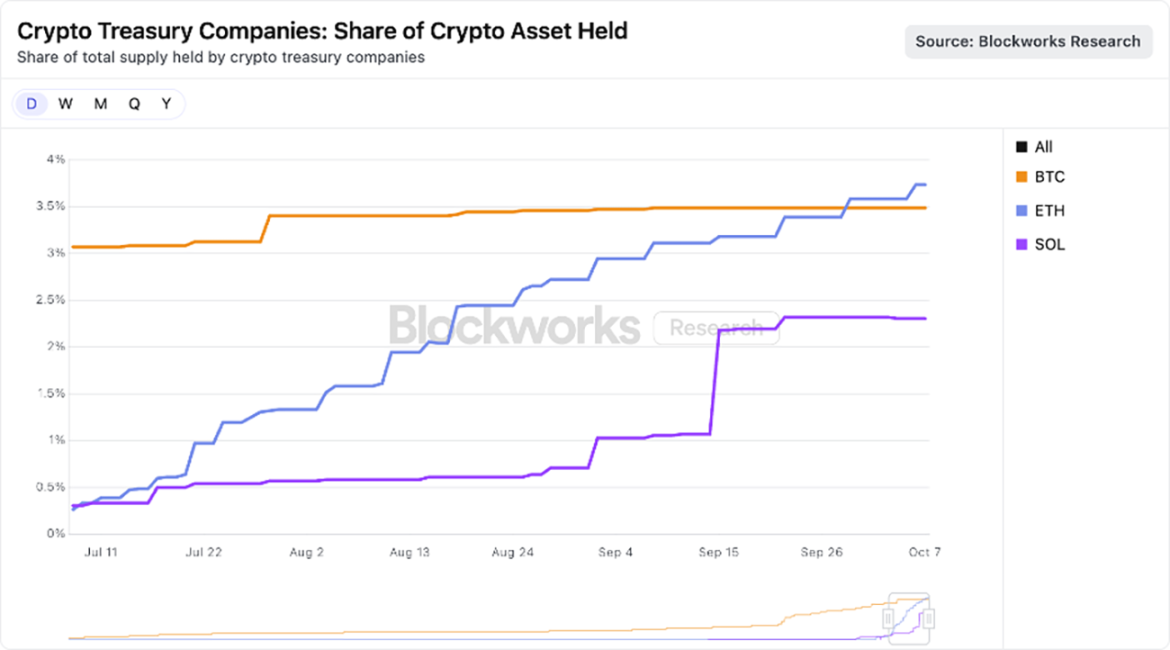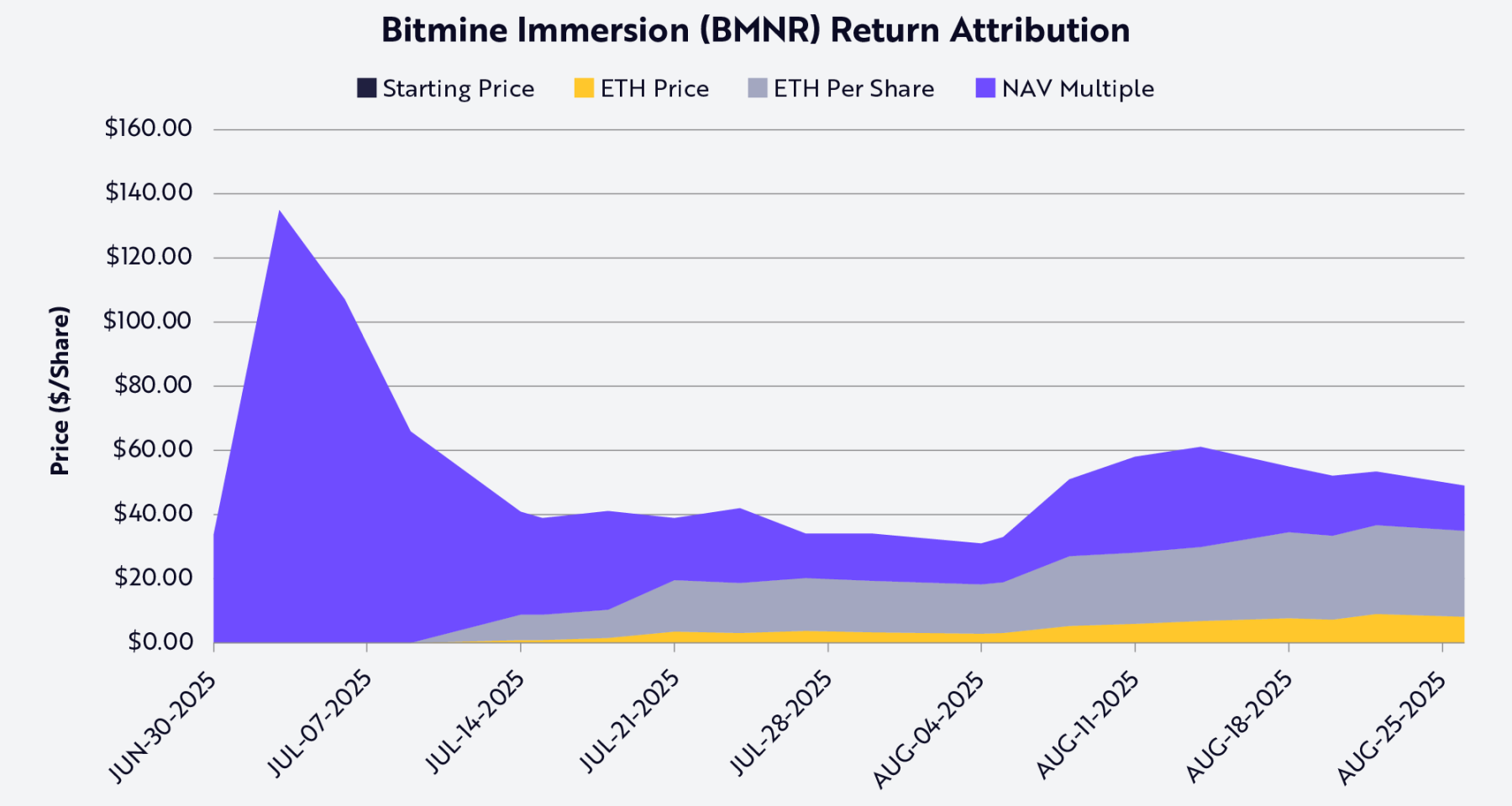Original author: Lorenzo Valente
Original translation by Chopper, Foresight News
From August to September 2025, Digital Asset Treasuries (DAT) became the core vehicle for the mainstreaming of crypto assets on Wall Street. This shift likely surprised many in the industry, who had expected exchange-traded funds (ETFs) to continue to dominate rather than be gradually replaced by DAT.
What exactly happened behind the scenes? Several years ago, Strategy pioneered the Bitcoin DAT model, but at the time, investors were unaware of how to apply it to other crypto assets. This article will delve into the market landscape and related controversies surrounding DAT.
Definition of DAT
Crypto Treasury (DAT) refers to companies that directly hold cryptocurrencies such as Bitcoin, Ethereum, and Solana on their balance sheets, allowing investors to indirectly gain exposure to crypto assets by purchasing their shares.
Unlike spot Bitcoin/Ethereum ETFs regulated by the U.S. Securities and Exchange Commission (SEC), which passively hold cryptocurrencies with their issued shares linked 1:1 to their holdings, DATs are operating companies that can manage their holdings through leverage, corporate strategy, or financing instruments. ETFs, as regulated public investment vehicles, provide compliant asset exposure; while DATs introduce corporate-level risk, with potential gains or losses exceeding the volatility of the underlying assets.
Long before the term "crypto treasury" even existed, Strategy had already created the first DAT for Bitcoin. Under Michael Thaler's leadership, the company downplayed its enterprise software business and focused entirely on accumulating Bitcoin. As of September 15, 2025, Strategy had purchased over 632,000 Bitcoins for $46.5 billion, at an average price of $73,527 per Bitcoin. Currently, the company holds more than 3% of the total Bitcoin supply of 21 million.
Strategy accumulated its Bitcoin holdings through a variety of financing strategies: initially issuing convertible senior notes, followed by senior secured notes with a coupon rate of 6.125%, but the real breakthrough came from its plan to issue shares at market value. Because its stock (ticker symbol MSTR) traded at a significant premium to its book value, Thaler diluted existing shareholder equity by issuing new shares, using the raised funds to purchase more Bitcoin and increase its Bitcoin holdings per share. Essentially, the funds provided by shareholders leveraged Strategy's Bitcoin exposure.
This model has sparked widespread controversy. Critics slam DATs for "selling a $1 asset for $2," meaning that if a DAT trades at twice its market capitalization net asset value (mNAV), investors are essentially paying $2 for a $1 Bitcoin on their balance sheet. They argue that this premium is neither reasonable nor sustainable.
However, Strategy's stock performance to date has overturned this assessment, delivering substantial returns to shareholders. Except for a brief period of discount during the bear market from March 2022 to January 2024, MSTR has consistently maintained a significant mNAV premium. More importantly, Thaler strategically capitalized on this premium: issuing shares at a price far exceeding book value to continuously increase Bitcoin holdings and achieve portfolio growth. Results show that since its initial Bitcoin purchase in August 2020, MSTR has not only allowed shareholders' Bitcoin exposure to compound, but its performance has also significantly outperformed a simple buy-and-hold strategy.
DAT Market Landscape
Five years after Strategy first purchased Bitcoin, hundreds of DAT tokens have now emerged. These new tokens are accumulating various crypto assets such as Ethereum, SOL, HYPE, ADA, ENA, BNB, XRP, TRON, DOGE, SUI, and AVAX.
The market is currently concentrating on large-cap assets, with several well-funded DATs vying to accumulate ETH and SOL. As shown in the chart below, DATs focused on ETH collectively hold 3.74% of the Ethereum supply, while Solana-affiliated DATs hold 2.31% of the SOL supply.

Data source: Blockworks, as of August 25, 2025
In our view, while some DAT issuances may be driven by short-term speculative motives, the ultimate winners may emerge as more efficient carriers of crypto assets than spot ETFs. Leveraging their corporate structure, DATs can utilize leverage, corporate financing, and strategic options—features unavailable to ETFs. These advantages will persist as long as their mNAV premium remains sustainable, a topic we will explore further in later chapters.
Why is AT's mNAV premium justified?
As an asset management firm with significant cryptocurrency exposure, ARK Invest has shown strong interest in the emerging DAT sector, recently investing in the leading Ethereum DAT, Bitmine Immersion. While we remain cautious about DATs and closely monitor their rapid development, we can understand some of the reasons why DATs command a premium over mNAV, primarily including the following:
Income / Pledged Proceeds
Smart contract L1 blockchains (especially Ethereum) offer native rewards through staking mechanisms, incentivizing users who participate in maintaining network security. In the crypto asset ecosystem, this reward is essentially equivalent to a "risk-free rate" because it originates within the protocol and does not involve counterparty risk.
In contrast, US spot ETFs do not allow staking on the underlying assets for profit. Even if regulators change their stance, due to the limitations of the Ethereum network design, ETFs can only stake a small portion of their holdings (potentially less than 50%) – Ethereum's "liquidity limit" dictates the number of validators that can join or leave each period. This limit is crucial for network security, preventing malicious attackers from instantly launching or shutting down a large number of validators, thus avoiding consensus mechanism or state management collapses. This means that the ETH staking or unstaking process can take up to two weeks. Although ETFs can circumvent this limit through liquidity staking protocols, compliance, liquidity, and centralization risks may prevent them from staking large positions.
DATs, on the other hand, offer greater operational flexibility. A typical DAT is a lean organization, usually operated by a small team, yet capable of generating substantial revenue. For example, Bitmine Immersion, if its market capitalization reaches $10 billion and all its ETH is staked, could generate approximately $300 million in free cash flow annually. These funds could be reallocated to mergers and acquisitions, token purchases, on-chain opportunities, or dividends.
hoarding speed
The speed of asset accumulation and the growth rate of crypto assets per share are key reasons for DAT's book value premium. The growth rate of crypto assets per share in DAT may exceed the price increase of the underlying asset itself, thereby accelerating revenue growth through staking rewards.
Take Bitmine as an example. On July 13th, the company held 163,142 ETH based on approximately 56 million fully diluted shares; at the then-current ETH price of $2,914, each share represented 0.0029 ETH, worth $8.45. Just 31 days later, according to our estimates, Bitmine's ETH holdings increased to 1.15 million, and its fully diluted shares increased to 173 million; at the then-current ETH price of $4,700, each share represented 0.0066 ETH, worth $32.43.
Within a month, the price of ETH rose by about 60%, while Bitmine's holdings of each ETH share increased by 130%. In other words, Bitmine created far more value than simply holding ETH by using an arbitrage model of "issuing shares at market price (ATM) + acquiring value-added shares".
Of course, this dynamic only holds true when an mNAV premium exists and ATM issuance has an added value effect. If the premium narrows or turns into a discount, DAT will have to rely on other capital market instruments, such as selling a portion of the underlying tokens to buy back shares.
Using the Shapley value decomposition method, Bitmine's (stock code BMNR) stock price performance can be attributed to three variables: ETH price, growth in ETH holdings per share, and changes in mNAV premium or discount (see chart below). As of August 25, ETH holdings per share were the biggest driver of BMNR's stock price and shareholder returns.

Data source: Ark Investment, as of August 25, 2025; Note: Based on Shapley's average value, only publicly available data is used.
Liquidity and low-cost funding
Liquidity is the core reason for the DAT premium. Issuing shares at market price (ATM) and convertible bonds are only feasible when the stock is liquid: ATMs rely on sufficient daily trading volume, requiring DATs to continuously issue shares without depressing the share price; the same applies to convertible bonds—investors are buying "bonds + conversion options," and the value of the options depends on sufficient stock liquidity for efficient selling or hedging. Illicit instruments fail to attract investors or lead to excessively high financing costs for the issuer.
Size is equally crucial, as the bond market typically serves large corporations. Investment banks and institutional lenders rely on secondary market demand, which in turn depends on a company's market capitalization and liquidity. In fact, most syndicated loans and institutional convertible bond issuances are only open to companies with a market capitalization exceeding $1 billion to $2 billion. Below this threshold, financing costs rise significantly, and access to funding is typically limited to customized or venture capital-style credit instruments. For example, Strategy was able to issue multiple rounds of convertible bonds totaling billions of dollars precisely because its stock was liquid and its market capitalization at the time was in the tens of billions of dollars.
This is also reflected in the issuance of preferred stock. The structured equity transactions adopted by Strategy require both a strong balance sheet and secondary market liquidity to attract institutional investors. Preferred stock buyers must be confident that they can exit or hedge their positions. DAT, lacking liquidity, could not obtain this financing channel.
In short, liquidity reduces financing costs. To compensate for the risk of insufficient liquidity, investors demand higher returns, so illiquid DATs must pay the price in one or more ways: higher equity issuance discounts, higher bond coupon rates, and more stringent contractual terms. Conversely, liquid DATs can raise funds at a lower cost to accumulate Bitcoin or Ethereum, creating a flywheel effect that amplifies the premium.
Strategic options
Many investors compare crypto assets (especially L1 tokens) to stocks, commodities, or currencies, but in reality, their differences far outweigh their similarities. DAT highlights this distinction and demonstrates that ETFs can be inefficient as vehicles for L1 assets. DAT's corporate structure provides "strategic options corresponding to book value premiums." Large DATs can acquire tokens at a discount during distress (e.g., during FTX's bankruptcy liquidation sale) or acquire other DATs trading below mNAV.
For example, Bitmine Immersion, with a market capitalization of $10 billion, could acquire $200 million worth of Ethereum DAT at a discount by issuing only 2%-3% of its shares, achieving a value-added acquisition. Besides mergers and acquisitions, ecosystems like Solana and Ethereum offer other opportunities: these networks host hundreds of billions of dollars in liquidity and applications, and sufficiently large DAT can generate revenue through "on-chain security maintenance" or "providing liquidity." In fact, protocols may offer incentives to attract well-funded participants to their ecosystems.
Another arbitrage opportunity lies in the "interest rate differential between traditional markets and on-chain rates," which sometimes exceeds 500 basis points (i.e., 5%). In a low-interest-rate environment, DAT can borrow USD at low cost from traditional financial markets and then deploy the funds in on-chain lending pools to obtain significantly higher returns. Currently, the annualized yield of stablecoin pools such as sUSDS, sUSDe, and SyrupUSDC is approximately 7%, which is about 300 basis points (3%) higher than the yield on US Treasury bonds, giving DAT the opportunity to obtain additional income streams beyond simple token appreciation.
risk
While DAT offers investors a new way to access crypto assets, it also brings significant risks that investors need to carefully weigh.
First, there is the reliance on market premiums. The DAT model (especially the growth per share of crypto assets) depends on the stock trading price being higher than mNAV. When the premium narrows, DAT's ability to increase value through issuing shares will weaken or even disappear, forcing it to slow down its acquisition pace or sell tokens to buy back shares.
Secondly, liquidity is a double-edged sword. While liquidity allows DAT to obtain low-cost funds, it can also trigger a liquidity crisis during market downturns. In a prolonged bear market, DAT may fall into a negative feedback loop: a sharp drop in stock price, rising financing costs, and potential redemption pressures forcing token sales.
Third, regulatory uncertainty is increasingly prominent. Unlike ETFs, DATs exist in a regulatory gray area, and their accounting treatment and information disclosure may face regulatory scrutiny—these regulatory requirements are more applicable to investment funds than to operating companies. Regulatory intervention may affect their access to capital market financing or limit their strategic options.
Fourth, governance and operational risks may be underestimated. Many DATs are managed by small teams with asset pools worth billions of dollars. Weak internal controls, poor risk management, or misaligned incentive mechanisms can all rapidly erode value. In the worst-case scenario, some DATs may become "disguised aggressive on-chain hedge funds"—pursuing returns, leveraging excessively, and lacking transparency in capital allocation, leading to hidden risks or even bankruptcy.
in conclusion
The rise of DAT has provided investors with a new way to access crypto assets. From Strategy's seemingly unconventional bet to its current widespread adoption, DAT has rapidly gained popularity on mainstream L1 blockchain protocols such as Ethereum and Solana. While critics dismiss its model as "selling a $1 asset for $2," the reality is far more complex.
DAT's corporate structure possesses unique potential advantages that ETFs cannot match, which is why it commands a book value premium: it can increase the value of each ETH or SOL share at a rate higher than the price of the underlying asset; it has liquidity and scale advantages, enabling it to access cheap capital throughout its capital structure; and it has opportunities for mergers and acquisitions, token purchases, and on-chain investments.
Unlike ETFs that passively hold crypto assets, DATs are dynamic capital market vehicles with the potential to amplify asset exposure, capture protocol returns, and optimize capital allocation. For some assets, DATs may not only be more sustainable than ETFs but also more efficient. They are not merely short-term arbitrage tools but could become long-term institutions bridging traditional financial markets and the new world of crypto assets.
- 核心观点:加密财库正取代ETF成为主流加密资产载体。
- 关键要素:
- DAT通过杠杆和战略管理持仓。
- DAT可获得质押收益和战略机会。
- DAT每股加密资产增速可超越标的。
- 市场影响:推动加密资产机构化,提供新投资渠道。
- 时效性标注:中期影响



